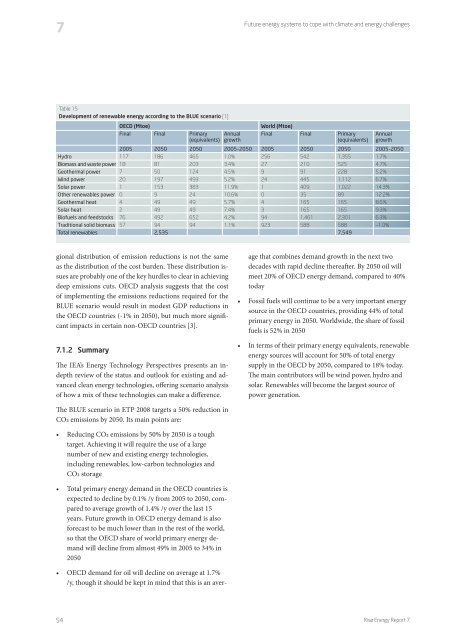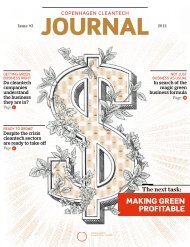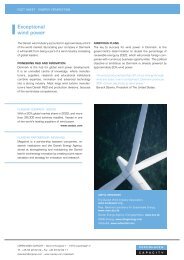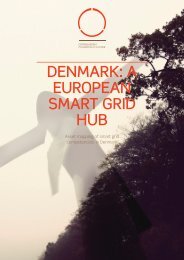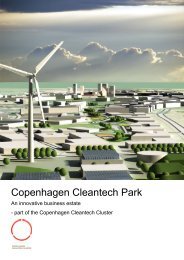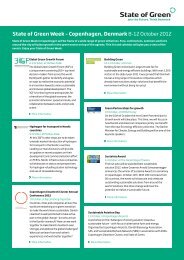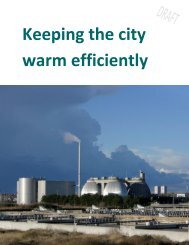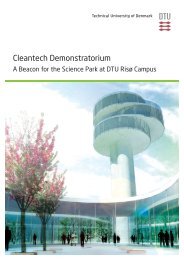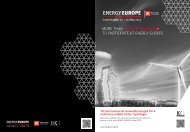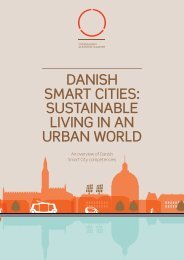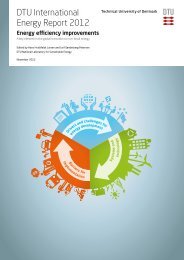<strong>Future</strong> <strong>energy</strong> <strong>systems</strong> to cope with climate and <strong>energy</strong> challenges7and cropping. Trucks, shipping, and air transport will be thechief consumers of biofuels, since other non-hydro<strong>carbon</strong>options are likely to be very expensive to apply to thesetransport modes.Table 14 shows the <strong>energy</strong> supply and demand consequencesof the BLUE scenario for the OECD countries and the worldas a whole.In the BLUE scenario, total primary <strong>energy</strong> demand in theOECD countries is expected to decline by 0.1% /y from 2005to 2050, which is significantly <strong>low</strong>er than the average 1.4% /ygrowth of the last 15 years. Growth in <strong>energy</strong> demand fromthe rest of the world is expected to be much higher, so thatthe OECD’s share of world primary <strong>energy</strong> demand will declinefrom almost 49% in 2005 to 34% by 2050.Demand for oil is forecast to decline by 0.8% /y globally, and however, that this is an average that encompasses globalgrowth in the next two decades, fol<strong>low</strong>ed by rapid decline.Owing to new policy initiatives to reduce CO2 emissions, thedemand for coal in the OECD region will decrease at 1.9%/y; world coal use will decline at 0.6% per year.CO2-neutral fuels will develop rapidly in the OECD between2005 and 2050. This applies to biomass and waste, whichwill grow at 3.7% /y, but especially to other renewables (includingwind power and solar), which are forecast to growstrongly at an average 5.7% /y over this time period. Evenin this extreme scenario, the OECD countries will still relyheavily on fossil fuels, which will provide 44% of their totalprimary <strong>energy</strong> in 2050. The global share of fossil fuels willbe 52% in 2050 according to the BLUE scenario.Accounting in terms of primary <strong>energy</strong> equivalents has itslimitations, as it is heavily influenced by the conventionsfor conversion efficiency, notably for nuclear and renewablepower. An analysis of final <strong>energy</strong> demand provides moreinsight into the role of renewables. In Table 15, power generationfrom renewable sources has been translated into primary<strong>energy</strong> equivalents using an efficiency of 40%, a referencevalue for power generation from fossil fuels.In BLUE renewables in power generation account for 67% oftotal renewables use in the OECD countries, but only 57% ofrenewables worldwide.In the power industry the role of renewable <strong>energy</strong> sourcesis forecast to increase significantly, making renewables thelargest source of power in this scenario. Globally, renewable<strong>energy</strong> including hydro will account for 46% of total powergeneration in 2050, compared to 18% today. For the OECDcountries the figures are 50% in 2050 compared to 18% today.BLUE assumes that biomass will be a key part of the renewable<strong>energy</strong> supply, and that primary bio<strong>energy</strong> use wouldgrow by nearly 200%. The type of biomass would be radicallydifferent from today: while the use of traditional biomass willdecline, biofuels and bio-feedstocks will grow significantly.In the transport sector, second-generation biodiesel and jetfuel from biomass would become important, since very fewsustainable <strong>energy</strong> alternatives exist for trucks, shipping andaviation.Emissions of CO2 are influenced by developments in <strong>energy</strong><strong>systems</strong> in two ways. On one hand, the general increase in<strong>energy</strong> consumption implies higher CO2 emissions, while onthe other, shifts in the <strong>energy</strong> mix away from fossil fuels tendto reduce emissions. In the BLUE scenario, CO2 emissionsfrom OECD countries will total 3.8 Gt in 2050, representinga decline of 71% compared to the present value, or an averagedecline of 2.7% /y. The global figures are more modest,with an average decline of 1.5% /y until 2050. By 2050 thenon-OECD countries would account for 72% of total globalCO2 emissions, and would have reduced their emissions by27% compared to the 2005 level.This analysis assumes least-cost decision-making as a basisfor the regional distribution of emissions reductions. Othercriteria would result in different distributions. Also, the re-Table 14World and OECD <strong>energy</strong> requirements under the BLUE scenario [1]CoalOilGasNuclearHydroBiomass and wasteOther renewablesTotalOECD (Mtoe)20051,1302,2471,211611109194395,54220504761,0438201,2591861,0094705,263World (Mtoe)2005–2050 2005–1.9%–1.7%–0.9%1.6%1.2%3.7%5.7%–0.1%2,8924,0002,3547212511,1496111,42920502,2512,8402,9512,1845423,6041,01315,3862005–2050–0.6%–0.8%0.5%2.5%1.7%2.6%6.4%0.7%Risø Energy Report 753
7<strong>Future</strong> <strong>energy</strong> <strong>systems</strong> to cope with climate and <strong>energy</strong> challengesTable 15Development of renewable <strong>energy</strong> according to the BLUE scenario [1]OECD (Mtoe)World (Mtoe)Final Final Primary Annual Final Final Primary Annual(equivalents) growth (equivalents) growth2005 2050 2050 2005–2050 2005 2050 2050 2005–2050Hydro 117 186 465 1.0% 256 542 1,355 1.7%Biomass and waste power 18 81 203 3.4% 27 210 525 4.7%Geothermal power 7 50 124 4.5% 9 91 228 5.2%Wind power 20 197 493 5.2% 24 445 1,112 6.7%Solar power 1 153 383 11.9% 1 409 1,022 14.3%Other renewables power 0 9 24 10.6% 0 35 89 12.2%Geothermal heat 4 49 49 5.7% 4 165 165 8.6%Solar heat 2 49 49 7.4% 3 165 165 9.3%Biofuels and feedstocks 76 492 652 4.2% 94 1,461 2,301 6.3%Traditional solid biomass 57 94 94 1.1% 923 588 588 –1.0%Total renewables 2,535 7,549gional distribution of emission reductions is not the sameas the distribution of the cost burden. These distribution issuesare probably one of the key hurdles to clear in achievingdeep emissions cuts. OECD analysis suggests that the costof implementing the emissions reductions required for theBLUE scenario would result in modest GDP reductions inthe OECD countries (-1% in 2050), but much more significantimpacts in certain non-OECD countries [3].7.1.2 SummaryThe IEA’s Energy Technology Perspectives presents an indepthreview of the status and outlook for existing and advancedclean <strong>energy</strong> technologies, offering scenario analysisof how a mix of these technologies can make a difference.The BLUE scenario in ETP 2008 targets a 50% reduction inCO2 emissions by 2050. Its main points are:age that combines demand growth in the next twodecades with rapid decline thereafter. By 2050 oil willmeet 20% of OECD <strong>energy</strong> demand, compared to 40%todaysource in the OECD countries, providing 44% of totalprimary <strong>energy</strong> in 2050. Worldwide, the share of fossilfuels is 52% in 2050<strong>energy</strong> sources will account for 50% of total <strong>energy</strong>supply in the OECD by 2050, compared to 18% today.The main contributors will be wind power, hydro andsolar. Renewables will become the largest source ofpower generation.target. Achieving it will require the use of a largenumber of new and existing <strong>energy</strong> technologies,including renewables, <strong>low</strong>-<strong>carbon</strong> technologies andCO2 storageexpected to decline by 0.1% /y from 2005 to 2050, comparedto average growth of 1.4% /y over the last 15years. <strong>Future</strong> growth in OECD <strong>energy</strong> demand is alsoforecast to be much <strong>low</strong>er than in the rest of the world,so that the OECD share of world primary <strong>energy</strong> demandwill decline from almost 49% in 2005 to 34% in2050/y, though it should be kept in mind that this is an aver-54Risø Energy Report 7


